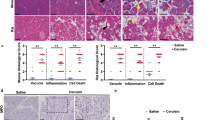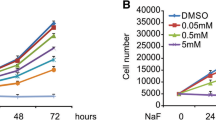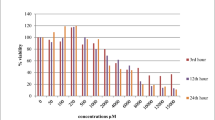Abstract
In rat exocrine pancreas cells, fluoride treatment causes autophagy resulting from intracisternal granule accumulation. Excessive autophagy might promote a type of programmed cell death different from apoptosis. To clarify how fluoride-induced autophagy and subsequent cell death occurs, we investigated morphological and biochemical changes in exocrine pancreas cells of rats subcutaneously injected with NaF saline solution at 20 mg/kg dose twice daily for 4 days. Intracisternal granule, excessive autophagy and ribosomal degranulation were observed in fluoride-exposed cells, occasionally with necrotic changes. Fluoride-induced rER-stress increased eIF-2α phosphorylation and CHOP expression, but did not affect GRP78. Spliced XBP-1 expression was decreased in damaged cells. These findings indicate that rER-stress by intracisternal granule accumulation lead to autophagy in exocrine pancreas cells without UPR, suggesting that signal process of autophagy differs from that of UPR-apoptosis. It is likely that intense degranulation is a turning point that damaged cells change over from autophagy, cell-protective process, to cell-death process.







Similar content being viewed by others
References
Blommaart EF, Krause U, Schellens JP, Vreeling-Sindelárová H, Meijer AJ (1997) The phosphatidylinositol 3-kinase inhibitors wortmannin and LY294002 inhibit autophagy in isolated rat hepatocytes. Eur J Biochem 243:240–246
Bursch W, Hochegger K, Török L, Marian B, Ellinger A, Hermann RS (2000) Autophagic and apoptotic types of programmed cell death exhibit different fates of cytoskeletal filaments. J Cell Sci 113:1189–1198
Bursch W, Ellinger A, Gerner C, Schulte-Hermann R (2004) Autophagocytosis and programmed cell death. In: Klionsky DJ (ed) Autophagy. Lamdes Bioscience, Georgetown
Calfon M, Zeng H, Urano F, Till JH, Hubbard SR, Harding HP, Clark SG, Ron D (2002) IRE1 couples endoplasmic reticulum load to secretory capacity by processing the XBP-1 mRNA. Nature 415:92–96
Clarke PG (1990) Developmental cell death: morphological diversity and multiple mechanisms. Anat Embryol 181:195–213
Cuervo AM (2004) Autophagy: in sickness and in health. Trends Cell Biol 14:70–77
Dever TE (1999) Translation inhibition: adapt at adapting. Trends Biochem Sci 10:398–403
Dunn WA Jr (1994) Autophagy and related mechanisms of lysosome-mediated protein degradation. Trends Cell Biol 4:139–143
Faitova J, Krekac D, Hrstka R, Vojtesek B (2006) Endoplasmic reticulum stress and apoptosis. Cell Mol Biol Lett 11:488–505
Harding HP, Zhang Y, Ron D (1999) Protein translation and folding are coupled by an endoplasmic-reticulum-resistant kinase. Nature 397:271–274
Harding HP, Calfon M, Urano F, Novoa L, Ron D (2002) Transcriptional and translational control in the mammalian unfolded protein response. Annu Rev Cell Dev Biol 18:575–599
Jiang H-Y, Wek RC (2005) Phosphorylation of the α-subunit of the eukaryotic initiation factor-2 (eIF2α) reduces protein synthesis and enhances apoptosis in response to proteasome inhibition. J Biol Chem 280:14189–14202
Kern HF, Kern D (1969) Elektronemikroskopische Untersuchungen ber die Wirkung von Kobaltchlorid auf das exokrine Pankreasgewebe des Meerschweinchens. Virchows Arch Abt B Zellpathol 4:54–70
Kitanaka C, Kuchino Y (1999) Casapase-independent programmed cell death with necrotic morphology. Cell Death Differ 6:508–515
Klionsky DJ, Emr SD (2000) Autophagy as a regulated pathway of cellular degradation. Science 290:1717–1721
Klionsky DJ, Ohsumi Y (1999) Vacuolar import of proteins and organelles from the cytoplasm. Annu Rev Cell Dev Biol 15:1–32
Lamparska-Przybysz M, Gajkowska B, Motyl T (2005) Cathepsins and Bid are involved in the molecular switch between apoptosis and autophagy in breast cancer MCF-7 cells exposed to camptothecin. J Physiol Pharmacol 56(Suppl 3):159–179
Lee K, Tirasophon W, Shen X, Michalak M, Prywes R, Okada T, Yoshida H, Mori K, Kaufman RJ (2002) IRE1-mediated unconventional mRNA splicing and S2P-mediated ATF6 cleavage merge to regulate XBP1 in signaling the unfolded protein response. Genes Dev 16:452–466
Lee A-H, Iwakoshi NN, Glimcher LH (2003) XBP-1 regulates a subset of endoplasmic reticulum resident chaperone genes in the unfolded protein response. Mol Cell Biol 23:7448–7459
Lee A-H, Chu GC, Iwakoshi NN, Glimcher LH (2005) XBP-1 is required for biogenesis of cellular secretory machinery of exocrine glands. EMBO J 24:4368–4380
Levine B, Klionsky DJ (2004) Development by self-digestion: molecular mechanisms and biological functions of autophagy. Dev Cell 6:463–477
Lockshin RA, Zakeri Z (2004) Apoptosis, autophagy, and more. Int J Biochem Cell Biol 36:2405–2419
Ma Y, Hendershot LM (2004) Herp is dually regulated by both the endoplasmic reticulum stress-specific branch of the unfolded protein response and a branch that is shared with other cellular stress pathways. J Biol Chem 297:13793–13799
Matsuo S, Nakagawa H, Kiyomiya K, Kurebe M (2000) Fluoride-induced ultrastructural changes in exocrine pancreas cells of rats: fluoride disrupts the export of zymogens from the rough endoplasmic reticulum (rER). Arch Toxicol 73:611–617
Mori K (2000) Tripartite management of unfolded proteins in the endoplasmic reticulum. Cell 101:451–454
Mori K (2003) Frame switch splicing and regulated intramembrane proteolysis: key words to understand the unfolded protein response. Traffic 4:519–528
Petiot A, Ogier-Denis E, Blommaart EFC, Meijer AJ, Codogno P (2000) Distinct classes of phosphatidylinositol 3′-kinases are involved in signaling pathways that control macroautophagy in HT-29 cells. J Biol Chem 275:992–998
Schroder RJ, Kaufman RJ (2005a) The mammalian unfolded protein response. Annu Rev Biochem 74:739–789
Schroder RJ, Kaufman RJ (2005b) ER stress and the unfolded protein response. Mutat Res 569:29–63
Seglen PO, Bohley P (1992) Autophagy and other vacuolar protein degeneration mechanisms. Experientia (Basel) 48:158–172
Seybold J, Bieger W, Kern HF (1975) Studies on intracellular transport of secretory proteins in the rat exocrine pancreas: II. Inhibition by antimicrotubular agents. Virchows Arch A Pathol Anat Histol 368:309–327
Sriburi R, Jackowski S, Mori K, Brewer JW (2004) XBP-1: a link between the unfolded protein response, lipid biosynthesis, and biogenesis of the endoplasmic reticulum. J Cell Biol 167:35–41
Sriburi R, Bommiasamy H, Buldak GL, Robbins GR, Frank M, Jackowski S, Brewer JW (2007) Coordinate regulation of phospholipid biosynthesis and secretory pathway gene expression in XBP-1(S)-induced endoplasmic reticulum biogenesis. J Biol Chem 282:7024–7034
Tallόczy Z, Jiang W, Virgin HWIV, Leib DA, Scheuner D, Kaufman RJ, Eskelinen E-L, Levine B (2002) Regulation of starvation- and virus-induced autophagy by the eIF2α kinase signaling pathway. Proc Natl Acad Sci USA 99:190–195
Tolkovsky AM, Xue L, Fltcher GC, Borutaite V (2002) Mitochondrial disappearance from cells: a clue to the role of autophagy in programmed cell death and disease? Biochimie 84:233–240
Tooze J, Kern HF, Fuller SD, Howell KE (1989) Condensation-sorting events in the rough endoplasmic reticulum of exocrine pancreatic cells. J Cell Biol 109:35–50
Wei MC, Zong WX, Cheng EH, Lindsten T, Panoutsakopoulou V, Ross AJ, Roth KA, MacGregor GR, Thompson CB, Kormeyer SJ (2001) Proapoptotic BAX and BAK: a requisite gateway to mitochondrial dysfunction and death. Science 292:727–730
Xue LZ, Fletcher GC, Tolkovsky AM (2001) Mitochondria are selectively eliminated from eukaryotic cells after blockade of caspase during apoptosis. Curr Biol 11:361–365
Yanagisawa H, Miyashita T, Nakano Y, Yamamoto D (2003) HSpin1, a transmembrane protein interacting with Bcl-2/Bcl-XL, induces a caspase-independent autophagic cell death. Cell Death Differ 10:798–807
Yorimitsu T, Nair U, Yang Z, Klionsky DJ (2006) ER stress triggers autophagy. J Biol Chem 281:30299–30304
Yoshida H, Matsui T, Yamamoto A, Okada T, Mori K (2001) XBP1 mRNA is induced by ATF6 and spliced by IRE1 in response to ER stress to produce a highly active transcription factor. Cell 107:881–891
Yoshimori T (2004) Autophagy: a regulated bulk degradation process inside cells. Biochem Biophys Res Commun 313:453–458
Zong WX, Lindsten T, Ross AJ, MacGregor GR, Thompson B (2001) BH3-only proteins that bind pro-survival Bcl-2 family members fail to induce apoptosis in the absence of Bax and Bak. Genes Dev 15:1481–1486
Author information
Authors and Affiliations
Corresponding author
Additional information
Ire1/XBP-1 is not activated in ER-induced autophagy.
The first and second authors contributed equally to this study.
Rights and permissions
About this article
Cite this article
Ito, M., Nakagawa, H., Okada, T. et al. ER-stress caused by accumulated intracistanal granules activates autophagy through a different signal pathway from unfolded protein response in exocrine pancreas cells of rats exposed to fluoride. Arch Toxicol 83, 151–159 (2009). https://doi.org/10.1007/s00204-008-0341-7
Received:
Accepted:
Published:
Issue Date:
DOI: https://doi.org/10.1007/s00204-008-0341-7




